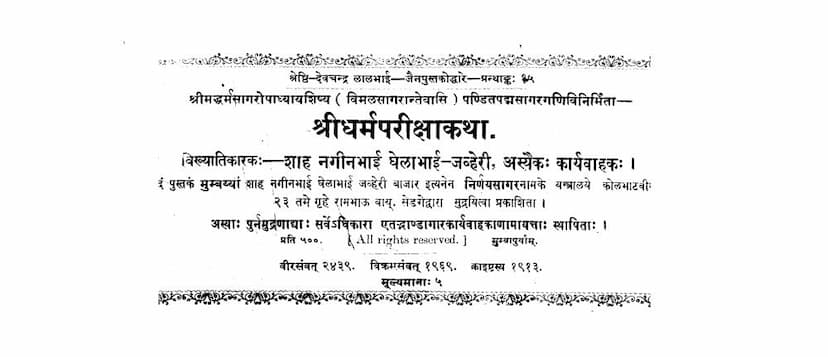Dharmpariksha Katha
Added to library: September 1, 2025

Summary
Here's a comprehensive summary of the Jain text "Dharmpariksha Katha" by Padmasagar Gani, based on the provided pages:
Book Title: Dharmpariksha Katha Author: Pandit Padmasagar Gani (disciple of Shri Dharmasagar Upadhyay) Publisher: Sheth Devchand Lalbhai Jain Pustakoddhar Fund Publication Date: April 1913 (Veer Samvat 2439, Vikram Samvat 1969) Catalog Link: https://jainqq.org/explore/034171/1
Overview:
"Dharmpariksha Katha" (The Story of the Examination of Dharma) is a Jain text that aims to compare religious concepts through anecdotes and narratives. Written by Pandit Padmasagar Gani, it is the 15th publication of the Sheth Devchand Lalbhai Jain Pustakoddhar Fund series. The work, completed in the Vikrama Year 1645 (1645 AD), seeks to elucidate the true nature of Dharma and the principles of Jainism by critically examining other religious beliefs and practices.
Key Themes and Content:
The text begins with invocations to Jain Tirthankaras and Goddess Sarasvati. It establishes the author's intention to expound upon the essence of Dharma, inspired by the works of earlier scholars. The core of the book is dedicated to illustrating the teachings of Jainism through allegorical stories and dialogues.
The narrative often features a protagonist, such as Manovega, who embodies the pursuit of truth and righteousness. Manovega encounters various situations and characters, often representing different philosophical viewpoints or flawed reasoning. Through these encounters, the text highlights the superiority of the Jain path.
Illustrative Anecdotes and Concepts:
The book is rich with allegorical stories that serve to explain complex philosophical ideas:
-
The Traveler in the Forest (Pages 8-10): This parable illustrates the perils of samsara (the cycle of birth and death). A traveler, pursued by an elephant (representing death), falls into a well. He clings to a tree, only to find a snake at the bottom and rats (black and white) gnawing at the roots of the tree. He finds solace in a single drop of honey from a beehive, representing the fleeting pleasures of the world. The story emphasizes the need for detachment and the pursuit of true Dharma to escape the cycle of suffering.
-
The Story of Pawanvega and Manovega: Pawanvega represents someone misled by false doctrines (mithyattva). Manovega, a virtuous and righteous friend, is deeply concerned about Pawanvega's spiritual state and seeks a way to guide him toward the right path. This narrative highlights the importance of true friendship in guiding others towards spiritual enlightenment.
-
Critique of Other Religions and Philosophies: A significant portion of the book involves the protagonist or wise characters engaging in debates or discussions that subtly critique the tenets of other faiths and philosophical schools. This is often done by exposing the logical inconsistencies, worldly attachments, or the propagation of falsehoods within those systems. The text frequently contrasts these with the purity and logical coherence of Jain principles. For example, it discusses:
- The Puranas: The text questions the narratives within the Puranas, pointing out contradictions and illogical elements (e.g., stories of deities engaging in worldly affairs, illogical transformations).
- Vedic Rituals: It implicitly critiques rituals like animal sacrifice (yajna) and the focus on worldly gains through them.
- Other Philosophies: The text touches upon various philosophies, often highlighting their lack of true detachment or their entanglement with worldly desires.
-
The Importance of Right Faith (Samyaktva): The story of Manovega's adherence to the Jain path, even when his friend is astray, underscores the value of correct understanding and faith in the Tirthankaras.
-
The Nature of Suffering and Pleasure: The parables often illustrate that worldly pleasures are transient and often lead to greater suffering, while true happiness is found in spiritual liberation and detachment.
-
The Characteristics of the Wise and the Ignorant: The narratives consistently contrast the actions and outcomes of those who adhere to Dharma (wisdom, detachment, peace) with those who are attached to worldly desires and false beliefs (ignorance, suffering, regret).
Literary Style and Approach:
- Allegory and Symbolism: The stories are rich in symbolism, where characters and events represent abstract concepts like death, time, virtue, vice, and various philosophical schools.
- Dialogue: The text employs dialogues to present different viewpoints and to facilitate the exposition of Jain teachings.
- Narrative Structure: The story often follows a protagonist on a journey of spiritual inquiry, encountering challenges and gaining wisdom through these experiences.
- Logical Argumentation: While using stories, the author often embeds subtle logical arguments to expose the weaknesses in non-Jain doctrines.
Purpose and Message:
The primary purpose of "Dharmpariksha Katha" is to:
- Educate: To provide a clear and engaging understanding of Jain philosophy and ethics.
- Discriminate: To help readers distinguish between true Dharma (Jainism) and other beliefs that might lead to spiritual downfall.
- Encourage Renunciation: To inspire detachment from worldly pleasures and an earnest pursuit of liberation.
- Promote Right Faith: To emphasize the critical role of Samyaktva (right faith) in the spiritual journey.
The book aims to convince readers that the path of Jainism, with its emphasis on non-violence, truthfulness, non-possession, celibacy, and penance, is the only true path to spiritual liberation and lasting happiness, contrasting it with the depicted shortcomings of other traditions.
Conclusion:
"Dharmpariksha Katha" is a significant Jain text that uses engaging narratives and allegorical stories to expound and defend the principles of Jain Dharma. It serves as a guide for seekers of truth, highlighting the eternal principles of right conduct, right knowledge, and right faith as the means to overcome the cycle of suffering and attain ultimate liberation.